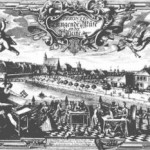I have never been to Leipzig yet, while listening to some music at home, a rather trivial detail took me into an imaginary trip to Katharinenstrasse and then to Santa Cruz, as it follows.
Having moved to Leipzig in 1723, Bach (it was what I listened to) started writing music for various open air festivities and celebrations, very popular in the baroque age (I need to confess I remembered lost of things about his life given an anthological phrase of Leonard Bernstein who said something like that: Back died in 1750 and that was great since he divided the 18th century in two precise halves).
Leipzig had an intense cultural life, not only a commercial one, and the grand parties taking place in town, almost weekly, were hosted either by the coffee shop or the Zimmermann gardens. People were sitting on the ground or on ad hoc built benches, willing to listen and to see such shows on that particular street or in parks and gardens. Given the number of librettos distributed to one show, it seems some 700 people could attend one.
The worldly cantatas he wrote were not quite an opera, yet were following a structure of arias and recitatives on mostly mythological topics. If you have not listed to those, I can tell you there are pieces you would like to hum, it is a lively and bright music, quite different to what you are used to listen to from Bach, the protestant and family man, as works commissioned privately, providing substantial additional income. In one of those cantatas, number 205, called Eolus pacified taking place on Katharinenstrasse, the place is the one influencing the score, and this is the small detail I referred to: Bach uses the real echo downside the square and introduces it into the music. The dialogue of the orchestra with the voices is based on the echo of the square and, in the end, the god of wind is reconciled.
This echo surprised by Bach in the square must have had an extraordinary effect alive, an interesting way of working with the sound and the public space. I do not realise how popular or how elitist such events were, but I think it was great that almost 250 years back people knew to enjoy about their places in such a subtle way.
If you search for Katharinenstrasse with Google Earth, it seems a rather ordinary place, nothing special about it (there is a larger box called art museum) and nothing seems to speak of that echo, but I find this lack very useful since it highlights the way events which we think are vulnerable in front of time, may mark the identify of a place in the memory of people, as solidly as architecture does. Exploring the space via sound and show is a fascinating topic for musicians, and a current example this time, a performance connected to Eolus again if this could be said, takes place on the shore of the ocean at Santa Cruz, with Evelyn Glennie (whose experiments I will talk about again) singing for surfers in a bay on a promontory over the water. Trumpets were resonating with the wind and the sound made by the waves and the cries of the surfers. The result was a musical composition in direct contact with that space and which had to react as swiftly as the surfers to any change around, be it of the wind or of the sound of the waves. On the other hand, this work looks at the very idea of the audience and that of a place for a performance or a public place where a performance happens. Starting with such examples of elaborated art manipulating the space through the sound and the sound through space, I hope I have invited you to think of topics connected to celebration, show and interaction in an animated town or place. I welcome you to visit Italy in this issue where we present Salone, the grand Milano event of interior design, and Esterni, another idea of how a place could be rethought, no matter how insignificant it may seem, and how any urban situation, no matter how modest, temporary and passing could be turned into a reason for a show, a celebration of a moment.


